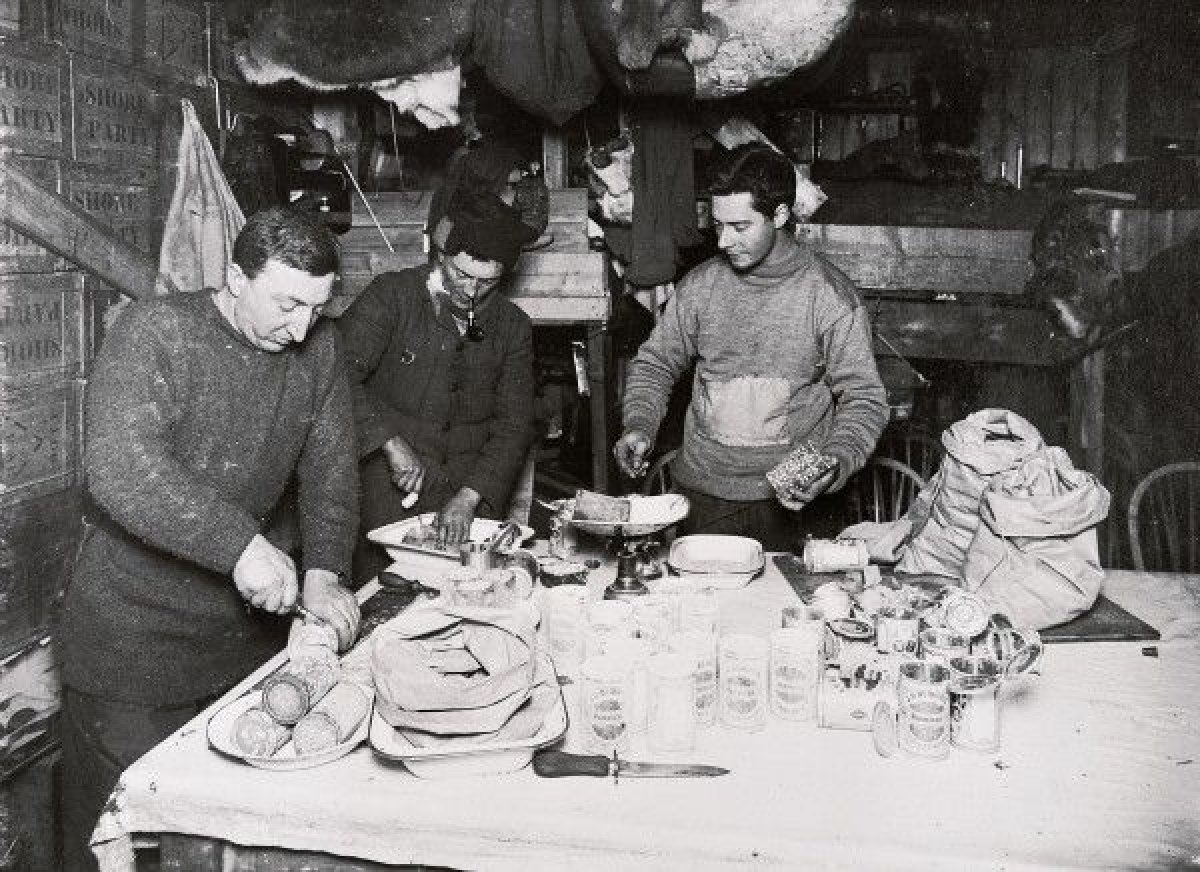In the first episode of The Terror, "Go for Broke," the men of the Franklin Expedition aren't worried about polar bear-like monsters, they're worried about disease. While debating the proper naval rank to assign the shipboard dog, David (Alfie Kingsnorth) begins spewing blood on the table. It's meant to remind cinema-savvy viewers of Alien, but for the officers of the expedition's two ships, Erebus and Terror, the young sailor's sudden sickness evokes something more terrifying, something so dangerous Captain Crozier (Jared Harris) won't even say the word aloud: scurvy.
Sailors with scurvy are exhausted, anemic and have aching limbs. But soon, more devastating symptoms emerge, including spontaneous bleeding, swelling and the disease's hallmark symptom: gum ulceration and, eventually, tooth loss. And it's just one of the horrific diseases that could strike down a sailor or an entire expedition.
The first episode of The Terror references three sailors already lost to disease, buried on Beechey Island. Like much of The Terror and it's source novel by Dan Simmons), the facts of the fictional story hew closely to the real-world events. Archaeologists exhumed and autopsied the sailors buried on Beechey in 1984, concluding they likely died of pneumonia or tuberculosis. The shipboard doctor in The Terror comes to a similar conclusion.
"Is it scurvy?" Franklin asks.
"Though I see nothing to mark it as such, I can't rule it out. But if I were to wager a guess at this point, I'd say the patient's consumptive. Doesn't always attack the lungs," the doctor reports, using the 19th century term for tuberculosis and describing a tubercular variation known as Pott disease. Tuberculosis was less a shipboard malady than a commonplace cause of death at the time, with nearly one-in-four deaths in England caused by TB, a bacterial infection, usually of the lungs, resulting in severe weight loss and a chronic, blood-mucus cough.

But, as The Terror depicts, what the sailors really feared was scurvy, believed to be contagious and spread by unsanitary conditions onboard. In reality, scurvy is caused by vitamin C deficiency, with some sufferers only showing symptoms after a month or longer. If everyone aboard is Vitamin C deficient, the spread of scurvy looks like a plague, as more and more sailors begin to succumb. But without accurate knowledge of the disease's cause, scurvy took on an almost spiritual dimension. It was commonly believed that poor hygiene, lack of exercise and low morale could bring about an epidemic of the disease. Scurvy killed more sailors than all shipwrecks, storms and other diseases combined, which explains why the possibility of one sailor having scurvy could induce such terror in the Franklin Expedition officers.

While many onboard Terror and Erebus feared scurvy, the disease was nearly licked by the time the crews set out. Scottish physician James Lind published A Treatise of the Scurvy in 1753, which not only narrowed down a more precise definition of a disease that had become for sailors a catch-all of boogeyman symptoms, but also announced a cure, discovered by Lind while treating scorbutic sailors in the Royal Navy. After testing popular sailor remedies, including vinegar and sea water, Lind found that administering oranges and lemons cleared up scurvy within a week. He was not the first to discover the treatment, though he did lift it above centuries-old sailor folklore. Lind's conclusion was contested for years (the president of the Royal Society preferred wort of malt), but finally adopted by the Royal Navy in 1795. The daily ration of lemon juice given to British sailors (as seen in The Terror), nearly eliminated scurvy and, as Harri Hemilä of Finland's Department of Public Health documents, likely contributed to major British naval victories over scurvy-ridden enemies, including their defeat of the French and Spanish fleet at the Battle of Trafalgar in 1805.
Since no one knew why citrus cured scurvy, there were many setbacks to its widespread use. Most dangerously, the adoption of key lime juice, lower in vitamin C, combined with vitamin-draining storage methods, threatened to upend Lind's theory entirely. Reversion to old superstitions led to shipboard scurvy deaths into the 20th century, including latter-day Antarctic expeditions. It wasn't until 1932 that a connection between scurvy and the vitamin C in ascorbic acid was finally established.

So while the officers and sailors of The Terror fear it, their daily shots of lemon juice make scurvy an unlikely culprit in expedition deaths, especially now that a monster is prowling around the frozen ships.
Highly contagious tuberculosis remains a problem for the crew, as does pneumonia, which is a lung inflammation rather than a disease itself. Without antibiotics, which wouldn't be discovered for decades, tubercular pneumonia is likely to spread aboard Terror and Erebus . No amount of Dover's Powder, a combination of ipecacuanha (the plant ipecac comes from) and opium powder designed to induce sweating, mentioned in the first episode, is going to restore dying sailors to health.
More dangerous still to the sailors of The Terror is a threat they never even suspected: lead poisoning. In the third episode, "The Ladder," the poor soldering in the tinned food is mentioned. When the real sailors from the lost Franklin Expedition were exhumed, they were found to have 10 times the normal lead concentration in their bones. Forensic anthropologists have theorized that lead poisoning, either from poorly soldered cans, or more likely, the expedition's unique water distillation system, contributed greatly to their eventual deaths. Lead poisoning causes nausea, diarrhea, numbness and, most dangerous of all, can inflame the brain in acute cases, drastically reducing the ability to think through problems. Faced with many, many obstacles to overcome, lead poisoning may have proven the difference between survival and death for the crews of Erebus and Terror.
Or, sticking to AMC's version, lead poisoning could mean the difference in reaction time between shooting the giant polar bear monster in the face, or getting your head ripped off.
The Terror airs Mondays on AMC.
Uncommon Knowledge
Newsweek is committed to challenging conventional wisdom and finding connections in the search for common ground.
Newsweek is committed to challenging conventional wisdom and finding connections in the search for common ground.
About the writer
To read how Newsweek uses AI as a newsroom tool, Click here.








